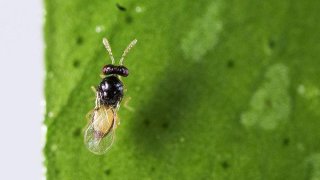
It sounds like the stuff of nightmares: thousands of tiny wasps are being released in areas of San Diego County this week. But the California Department of Food and Agriculture (CDFA) says the minuscule bugs are actually the good guys.
The wasp, called Tamarixia radiata, are being released to fight off another tiny disease-carrying bug that could devastate citrus crops -- the Asian citrus psyllid (ACP).
Get San Diego local news, weather forecasts, sports and lifestyle stories to your inbox. Sign up for NBC San Diego newsletters.
The insect is less than a millimeter long, even smaller than a fruit fly, but looks like a wasp with wide-set eyes, antenna and long clear wings.
While the Tamarixia radiata is completely harmless to human and pets, it's detrimental to the ACP, which carries the devastating citrus tree disease Huanglongbing (HLB). The wasp will lay eggs inside the ACP, which then hatch and consume the psyllid from the inside.
The CDFA says that while the HLB disease has not yet been found in San Diego, the disease-carrying bug has. Once the disease invades a tree, there is no cure.
Local
Dr. David Morgan, CDFA biological control program manager, said the psyllid are much harder to control in urban areas but can spread to commercial crops if they're not taken care of.
That's why the department has been releasing thousands of wasps in urban areas of San Diego County, including in Escondido, Bonsall and Fallbrook, where the majority of San Diego County's citrus crop lies. Controls will also be conducted in Imperial Beach, Chula Vista, San Diego and San Ysidro. To see where controls have occurred, check out this map.
To the north, the disease has been found in about 2,000 citrus trees in residential areas across Los Angeles, Orange, Riverside and San Bernardino counties. Biological control measures are being used there, too.
But residents can do their part to ensure the parasite can do its job, the CDFA says. Ants can interfere with their efforts, so residents are asked to use traps and other methods to mitigate ants around citrus trees. Inspect citrus trees monthly for signs of the Asian citrus psyllid. Check new leaves to find them and if you find the bug, call 800-491-1899. More tips can be found here.
The idea to use the Tamarixia radiata to control HLM was developed by a partnership between the University of California, the Citrus Research Board, the U.S. Department of Agriculture and the CDFA.
According to research published by UC Riverside's Dr. Mark Hoddle in 2018, the ACP population had declined by about 70% since the Tamarixia radiata were introduced to Southern California.
The wasp was brought to the region from Pakistan and was studied for years as a form of biological control before nearly 300 wasps were released in certain Southern California areas for the first time in 2011.



